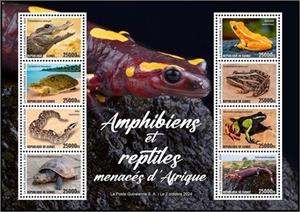Mini Sheet: Endangered Amphibians and Reptiles of Africa (Guinea 2024)
Endangered Amphibians and Reptiles of Africa (Guinea 2024)
02 October (Guinea ) within release Endangered Species (2024) goes into circulation Mini Sheet Endangered Amphibians and Reptiles of Africa face value 8*25000 Guinean franc
| Mini Sheet Endangered Amphibians and Reptiles of Africa in catalogues | |
|---|---|
| Colnect codes: | Col: GN 2024.10.02-004 |
Mini Sheet is square format.
Also in the issue Endangered Species (2024):
- Full Pane - Endangered Amphibians and Reptiles of Africa face value 16*15000;
- Mini Sheet - Endangered Amphibians and Reptiles of Africa face value 8*25000;
Mini Sheet Endangered Amphibians and Reptiles of Africa it reflects the thematic directions:
Amphibians are ectothermic, anamniotic, four-limbed vertebrate animals that constitute the class Amphibia. In its broadest sense, it is a paraphyletic group encompassing all tetrapods, excluding the amniotes (tetrapods with an amniotic membrane, such as modern reptiles, birds, and mammals). All extant (living) amphibians belong to the monophyletic subclass Lissamphibia, with three living orders: Anura (frogs), Urodela (salamanders), and Gymnophiona (caecilians). Evolved to be mostly semiaquatic, amphibians have adapted to inhabit a wide variety of habitats, with most species living in freshwater, wetland or terrestrial ecosystems (such as riparian woodland, fossorial and even arboreal habitats). Their life cycle typically starts out as aquatic larvae with gills known as tadpoles, but some species have developed behavioural adaptations to bypass this.
Reptiles are tetrapod (four-limbed vertebrate) animals in the class Reptilia, comprising today's turtles, crocodilians, snakes, amphisbaenians, lizards, tuatara, and their extinct relatives. The study of these traditional reptile orders, historically combined with that of modern amphibians, is called herpetology. Because some reptiles are more closely related to birds than they are to other reptiles (e.g., crocodiles are more closely related to birds than they are to lizards), the traditional groups of "reptiles" listed above do not together constitute a monophyletic grouping (or clade). For this reason, many modern scientists prefer to consider the birds part of Reptilia as well, thereby making Reptilia a monophyletic class.


